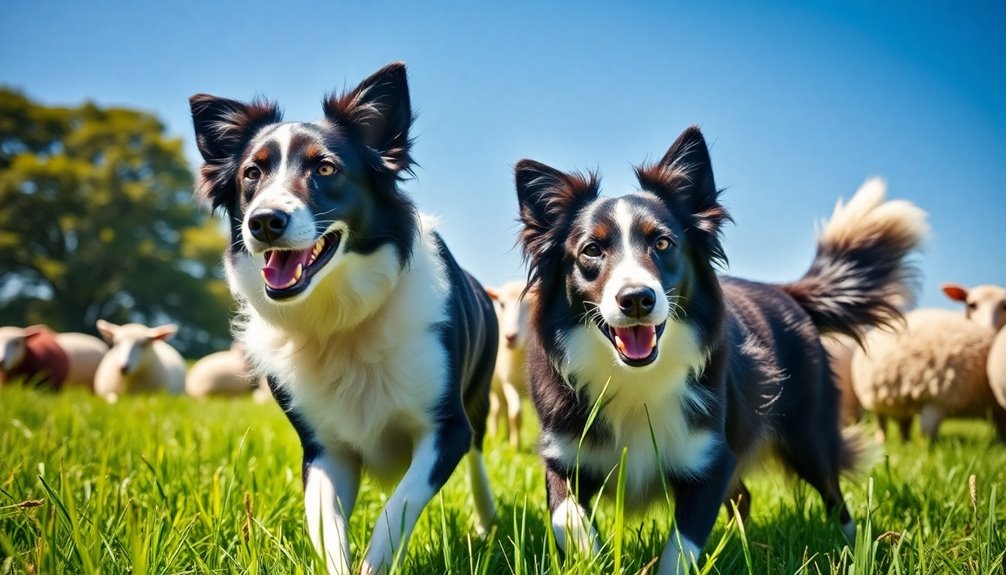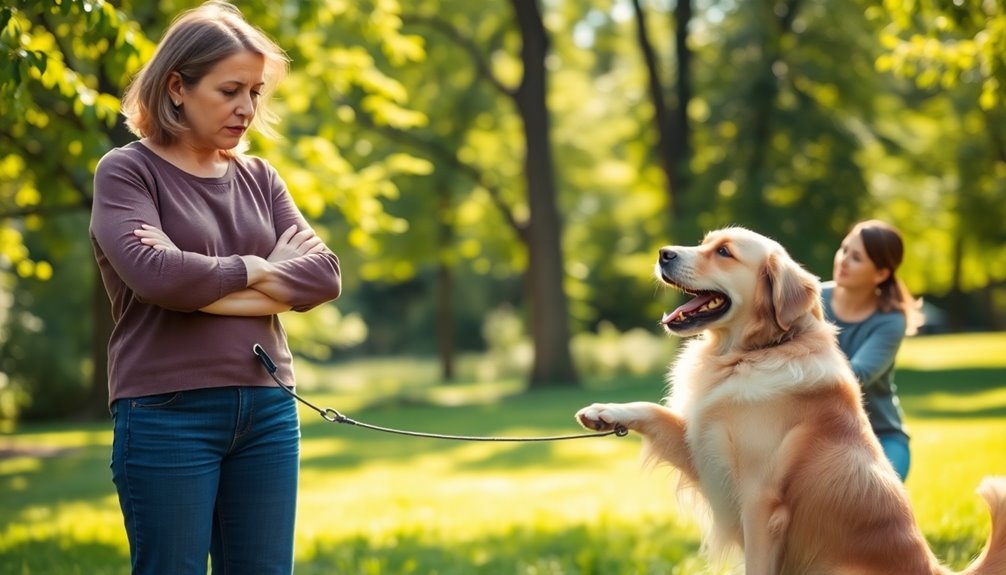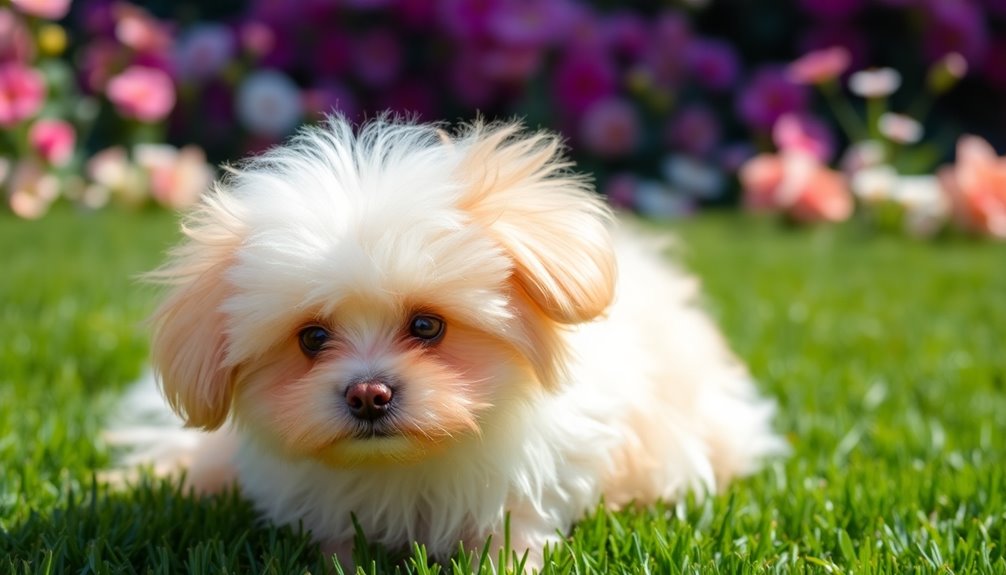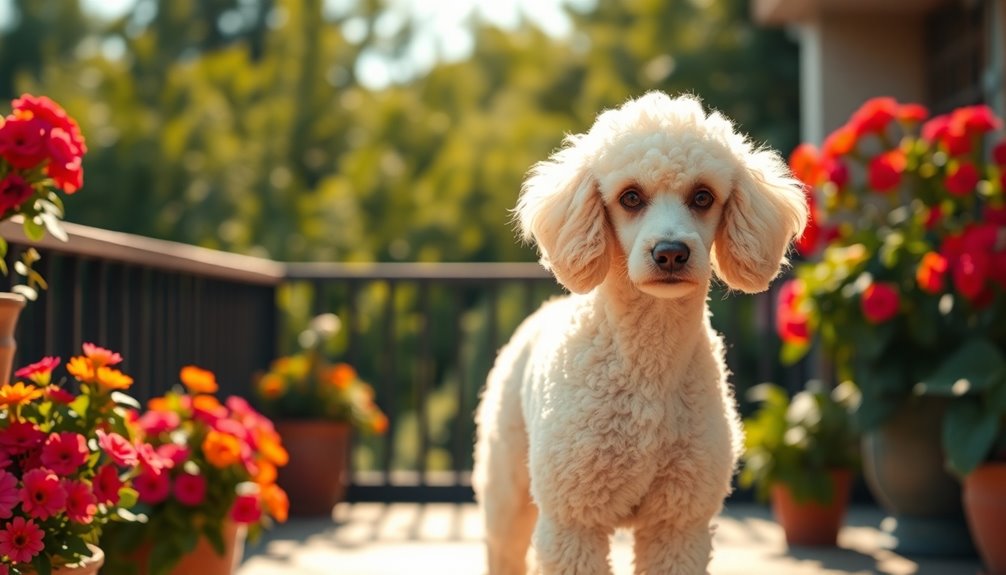Border Collies are often hailed as the smartest dog breed, and for good reason. Originating in the British Isles, these medium-sized dogs excel in training due to their exceptional problem-solving skills and strong desire to please. With a remarkable ability to learn commands after just a few repetitions, they thrive on mental stimulation and physical activity. Their affectionate nature makes them great companions, but their high energy requires plenty of exercise. If you're curious about their unique traits, health needs, or ideal living conditions, there's much more to explore about these incredible dogs.
Key Takeaways
- Border Collies are renowned for their intelligence, learning commands with fewer than five repetitions and exhibiting a 95% success rate in obeying commands.
- They can learn over 1,000 proper-noun names, showcasing advanced linguistic skills and problem-solving abilities.
- Originating as herding dogs, they require mental and physical stimulation to thrive and prevent behavioral issues.
- Early socialization and supervision are essential to manage their natural herding instincts and maintain a balanced temperament.
- Regular exercise and mental challenges, like puzzle toys, are crucial to their well-being and overall happiness.
Introduction
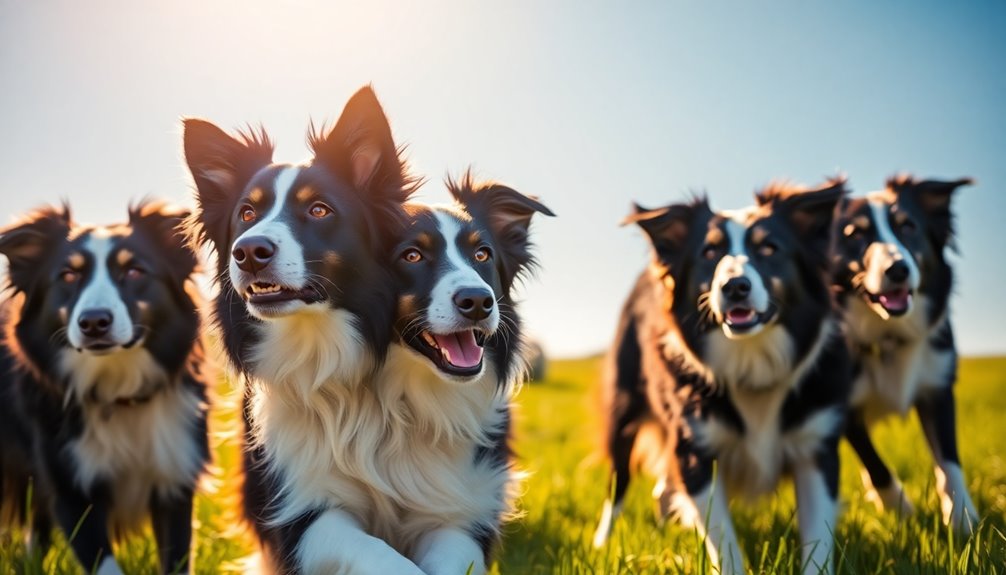
Since their origins as herding dogs in the British Isles, Border Collies have captured the hearts of dog lovers worldwide, not just for their stunning looks but also for their remarkable intelligence.
These medium-sized dogs typically weigh between 31 and 44 pounds and stand 18 to 22 inches tall at the shoulder. With their medium-length double coat, they come in a variety of colors, including black, red, bi-color, and even merle.
Regarded as the smartest dog breed, Border Collies learn commands quickly, often mastering new tasks in fewer than five repetitions. Their intelligence goes beyond mere obedience; they excel at problem-solving and logical reasoning, making them ideal for roles in police work and search-and-rescue operations. Additionally, their high energy levels make them happiest when engaged in structured activities, such as herding work.
However, their high energy levels demand over 40 minutes of exercise daily, so be prepared to keep them active.
These dogs also have strong herding instincts, which can lead them to nip at children or other pets. Because of their protective nature and social needs, early socialization is crucial.
If you're considering a Border Collie, ensure you can provide ample physical and mental stimulation to keep them happy and engaged.
History and Origin
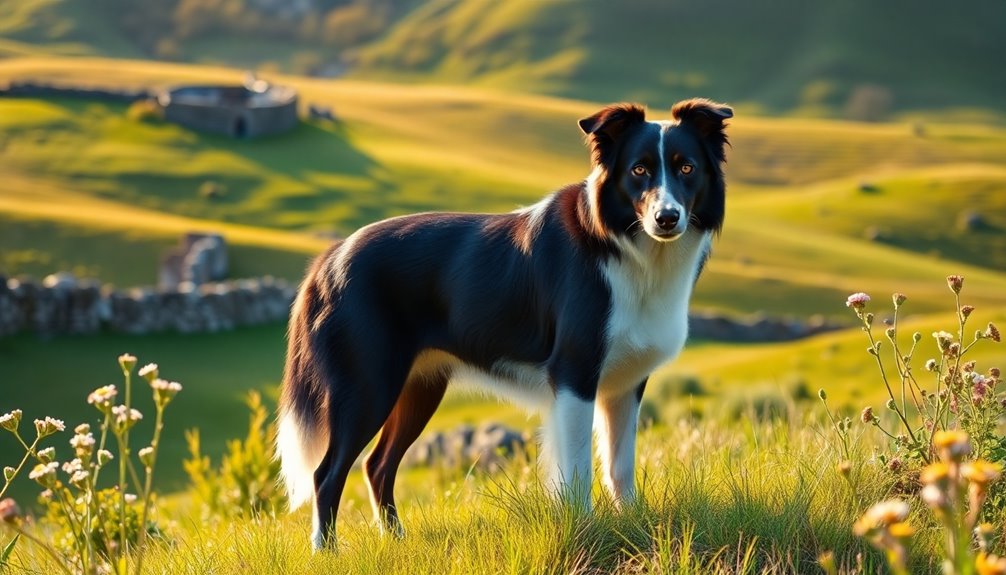
You might be surprised to learn that the Border Collie's origins trace back to the British Isles, where Roman invaders brought herding dogs over two thousand years ago. These dogs became essential for efficiently managing livestock across the regions of England and Scotland. Over centuries, they evolved into the remarkable breed we recognize today, thanks to their exceptional herding skills and intelligence. The common ancestor of all Border Collies, known as Old Hemp, was born in 1893 and is credited with significantly shaping the breed's development.
Where and when the breed originated
Border Collies have a rich history that traces back to the late 1700s and early 1800s in Northumberland, a region straddling the border of England and Scotland. This area, known for its rugged terrain and agricultural needs, played a crucial role in the breed's development.
The term "Border Collie" itself comes from this Anglo-Scottish border region, where traditional sheepdogs thrived. The breed's foundation was shaped by the demands of herding livestock, particularly sheep, in this challenging landscape. Strong eye instinct is a defining characteristic of working lines, which further enhances their herding capabilities.
One of the most notable ancestors of the Border Collie, Old Hemp, was bred by Adam Telfer in 1893 and is recognized for his exceptional herding abilities and intelligence. By the late 1800s, sheepdog trials began to emerge, showcasing the skills of these remarkable dogs.
In 1915, James Reid of the International Sheep Dog Society formalized the term "Border Collie," further establishing the breed's identity. The International Sheep Dog Society also started a stud book to document these dogs, with Old Hemp listed as an early entry.
As the breed gained popularity, organizations like the American Border Collie Association emerged to preserve its heritage.
Herding Livestock Efficiently
As the demand for effective livestock management grew, farmers and shepherds across Great Britain turned to the Border Collie for its unmatched herding skills. Developed over 300 years, these dogs became essential for managing large herds of sheep and cattle across vast regions.
Before the invention of barbed wire fencing in 1874, herding dogs were crucial for containing and moving livestock over long distances.
Border Collies excel in gathering, driving, sorting, and holding stock in place. Their instinct to go to the heads of livestock prevents escape, while their intense glare intimidates animals into compliance. They can efficiently work with various livestock types, including sheep, cattle, goats, and even poultry. Their strong work ethic and intelligence make them particularly suited for this demanding role.
Training a Border Collie begins with mastering basic commands like 'sit' and 'stay,' progressing to specific herding commands such as 'walk up' and 'come by.'
Using obstacles for realistic training scenarios helps regulate their distance from the flock, ensuring effective herding. Directional commands, like 'left' and 'right,' along with whistle signals, enhance communication between you and your dog, making them an invaluable asset in livestock management.
Physical Characteristics
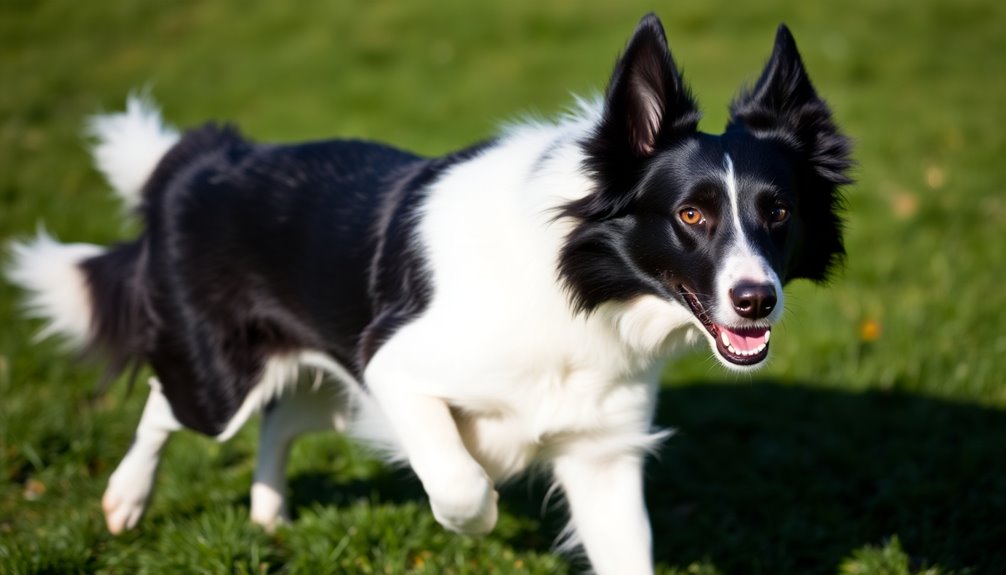
When you look at a Border Collie, their size and weight can vary quite a bit, with males standing 18-22 inches tall and females slightly shorter. Their coats come in various colors and lengths, adding to their unique appearance, while their fluffy tails and expressive eyes give them a charming personality. As you observe these physical traits, you'll see how they contribute to the breed's overall energetic and athletic build. These dogs typically weigh between 30–45 lbs, showcasing their medium-sized stature.
Size, weight, and coat details
With a well-defined size range, Border Collies typically stand between 19 to 22 inches tall for males and 18 to 21 inches for females, making them a medium-sized breed. They reach their maximum height and weight by around 1.5 to 2 years old, with individual growth rates varying based on nutrition, exercise, and genetics. Regular veterinary care ensures optimal health and development, which is particularly important for preventing genetic issues.
If you have a six-month-old Border Collie, expect them to grow a few more inches before reaching their adult height.
In terms of weight, males generally weigh between 30 to 55 pounds, while females range from 27 to 42 pounds, or up to 45 pounds. By six months, male puppies typically weigh 20-25 pounds, and female puppies weigh about 18-22 pounds.
Border Collies come in two coat types: rough and smooth. The rough coat, more common in shows, has a coarse, slightly wiry outer layer and a softer undercoat.
This double coat sheds seasonally, so regular grooming is essential to maintain its health. You'll find them in various colors, including black, blue merle, and red, often with unique patterns and combinations that enhance their striking appearance.
Fluffy Tail and Expressive Eyes
Border Collies boast a fluffy tail that's not just for show; it plays a crucial role in their balance and agility. Their tail is moderately long and set low on the back. You'll notice that it's well-furnished, often swirling upward at the end. In moments of excitement, it may rise to the level of their back, but it rarely arches over it, as that's not ideal for working dogs.
Now, let's talk about those expressive eyes. Typically brown, Border Collies can also have blue, grey, or a mix of colors. Some have a striking wall eye, where one eye contrasts with the other. Their oval-shaped eyes are set well apart, exuding a keen and alert intelligence. This distinctive appearance isn't just for looks; it indicates their focus and intent, especially during herding.
When it comes to coloration, their fur can range from black to red, with various white markings. The feathering on their legs, tail, and around the ears enhances their overall charm. Interestingly, Border Collies come in a variety of coat types that can include smooth or rough textures, further adding to their unique appeal.
Together, the fluffy tail and expressive eyes create the captivating presence that makes Border Collies so beloved.
Temperament and Personality
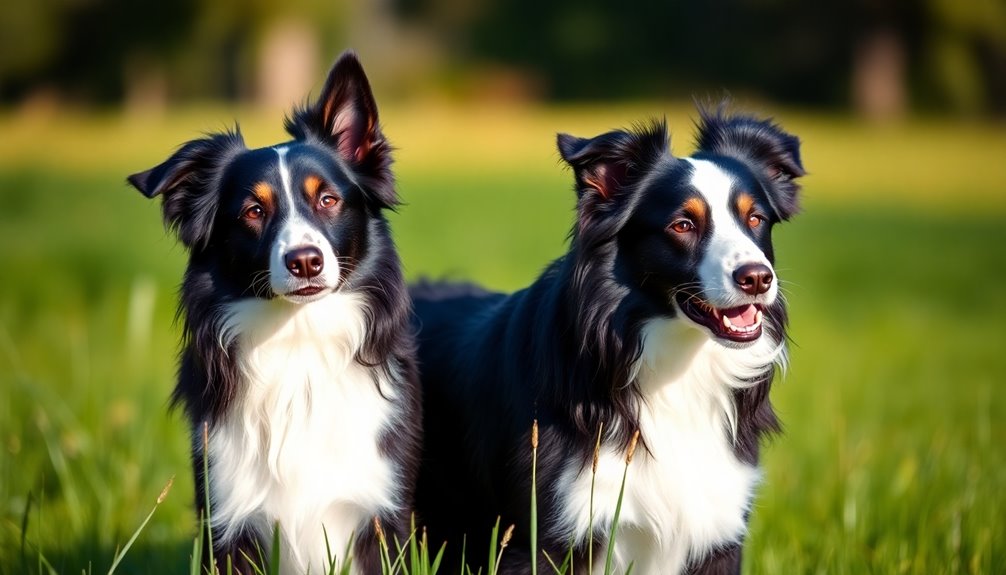
When you consider a Border Collie, you're looking at a dog that's not just highly intelligent but also incredibly trainable.
These pups are great for families, individuals, and even other pets, as long as you manage their herding instincts. Their loving and affectionate nature makes them a joy to have around, but they do need plenty of mental and physical stimulation to thrive. Additionally, their natural herding instincts require clear boundaries around children and other pets to ensure a harmonious environment.
Highly Intelligent and Trainable
Training a Border Collie can be an incredibly rewarding experience, thanks to their exceptional intelligence and trainability. You'll find that they can learn new commands with fewer than five repetitions, far surpassing the 25-50 repetitions needed by other breeds. With a 95% success rate in obeying known commands on the first try, they make training a breeze.
Consistency, positive reinforcement, and reward-based methods work best, and they thrive on mental stimulation. Start training early to shape good behaviors and curb any problematic herding instincts. Their remarkable problem-solving abilities shine during obstacle courses, where they navigate with precision and creativity. These dogs can assess situations and devise swift solutions like a young human child. Furthermore, their high instinctive intelligence allows them to excel in various tasks with minimal guidance.
Border Collies also boast advanced linguistic skills. They understand a wide range of commands and can differentiate between various toys based on verbal cues. Their ability to learn over 1,000 proper-noun names demonstrates their impressive memory.
Ultimately, their adaptive intelligence and creativity allow them to tackle challenges with ease, making them not just highly intelligent, but also truly unique companions.
Suitability for families, individuals, or other pets
The Border Collie's temperament makes it a versatile choice for families, individuals, and those with other pets. Their friendly nature allows them to bond well with children, adults, and other dogs if properly trained. However, their herding instincts can lead to nipping or chasing young children without appropriate guidance. Early socialization is crucial, and supervision is essential to ensure safe interactions. For families with older kids, Border Collies can thrive, as they enjoy engaging activities that older children can provide. Additionally, incorporating positive reinforcement techniques can significantly enhance training outcomes.
If you lead a more individual lifestyle, consider your activity level. Border Collies need significant physical and mental stimulation, so they're not a match for a sedentary lifestyle. They require space to run and play, making apartment living generally unsuitable. Additionally, responsible pet ownership is key to ensuring successful integration of Border Collies into family life. Training plays a key role in maintaining harmony within the family or individual setting. Proper training helps manage their energy and herding instincts, preventing behavioral issues.
Using positive reinforcement techniques and providing regular mental challenges will strengthen your bond and keep your Border Collie happy and well-adjusted.
Health and Lifespan
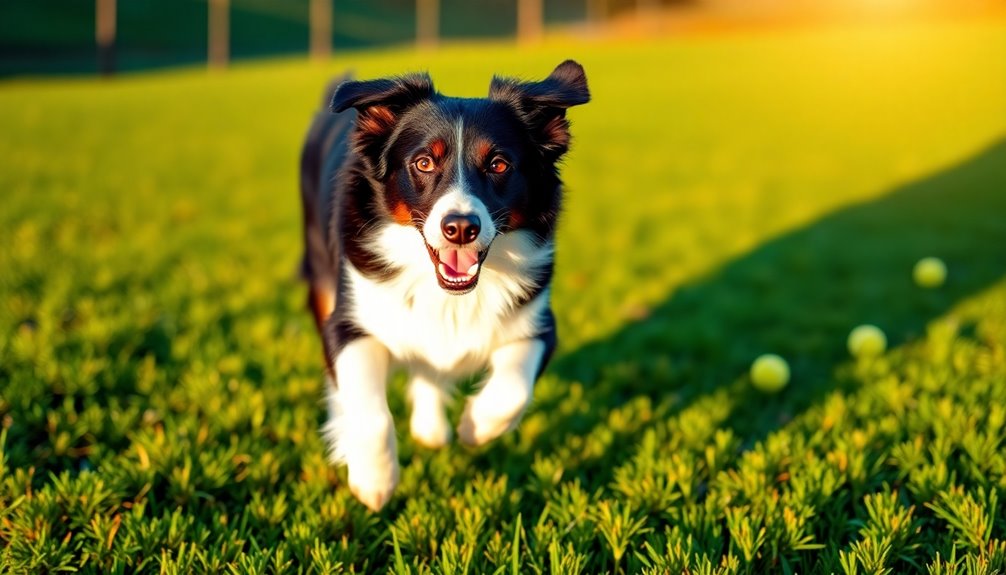
When it comes to your Border Collie's health and lifespan, understanding common genetic issues is crucial.
These dogs typically live between 12 to 15 years, but factors like genetics and lifestyle can influence their longevity. To ensure your pup stays healthy, regular check-ups and a nutritious diet are key. Additionally, maintaining an active lifestyle is essential for promoting overall well-being and longevity.
Typical lifespan of the breed
Border Collies typically enjoy a lifespan ranging from 12 to 15 years, with some living up to 17 years or even longer. The oldest recorded Border Collie lived an impressive 28 years, showcasing the breed's potential for longevity.
However, several factors can influence how long your furry friend stays by your side. Genetics plays a significant role in determining lifespan, but health conditions and diseases can also have an impact. Your dog's environment and lifestyle are crucial; providing regular veterinary check-ups, quality nutrition, and a balanced diet are essential for promoting a longer life. Additionally, routine veterinary visits can enhance longevity and quality of life.
Border Collies thrive on at least 2 hours of daily exercise, so keeping them active not only supports their physical health but also enhances their mental well-being. Engaging activities prevent behavioral problems, making your bond stronger.
Regular grooming and preventive measures like vaccinations and parasite control further contribute to their overall care. As your Border Collie ages, you'll notice signs like decreased mobility and energy.
The senior stage begins around 9 years of age, and it's vital to adjust exercise routines and ensure specialized care during this time for the best quality of life.
Common health concerns or genetic predispositions
Understanding common health concerns and genetic predispositions is essential for keeping your Border Collie healthy and thriving. One significant issue is hip dysplasia, which can lead to osteoarthritis and lameness. Approximately 10.8% of Border Collies are affected, and it's diagnosed through radiographic evaluation. Your dog's diet and exercise can influence this condition.
Collie Eye Anomaly (CEA) is another concern, a recessive genetic disorder affecting the eyes, with an incidence rate of less than 2.5%. An ophthalmological exam can diagnose this condition, and genetic tests are available for screening.
Epilepsy is also a potential issue, with an estimated incidence of less than 5%. While there's no specific genetic test, physical and neurological exams can help diagnose it.
Exercise-Induced Border Collie Collapse (BCC) is triggered by strenuous activity, causing disorientation and staggering. It's moderately heritable, and recovery usually occurs within 30 minutes of rest. Recent studies show that the heritability of BCC risk is approximately 49-61%, highlighting its genetic influence.
Additionally, genetic mutations related to multidrug resistance and malignant hyperthermia can pose risks. Early testing and awareness of these conditions can significantly impact your Border Collie's health and longevity.
Tips for maintaining health and wellness
Maintaining your Border Collie's health and wellness is vital for ensuring a long, happy life together. Regular veterinary care is your first step. Schedule check-ups every six months to catch any health issues early, ensuring vaccinations, dental care, and parasite prevention are all up to date. Your vet will assess your dog from nose to tail, so don't skip these important visits.
Next, focus on a balanced diet tailored to your dog's age, weight, and activity level. Consult your vet for recommendations, especially if your dog has specific health concerns. A nutritious diet supports optimal physical condition, so avoid artificial additives. Additionally, consider incorporating omega-3 fatty acids into their diet to help reduce inflammation and support overall health.
Exercise is crucial for your Border Collie's physical and mental health. Aim for at least two 30-minute walks daily and incorporate activities like running, agility training, and fetch. Keep routines varied to keep things exciting.
Lastly, provide mental stimulation through puzzle toys, training sessions, and games. Regular grooming, including brushing and dental care, is equally important. Consider dental chews to help maintain oral hygiene.
Care Requirements
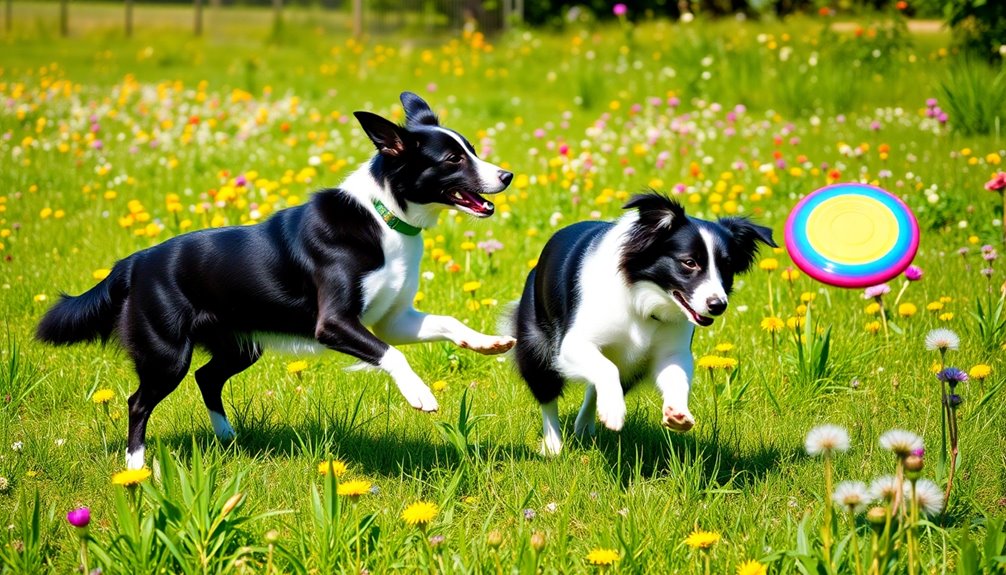
When you bring a Border Collie into your home, you'll need to stay on top of their care requirements to keep them happy and healthy. Regular brushing is crucial to manage their shedding, and you'll need to provide ample exercise to match their high energy levels. Additionally, focusing on a balanced diet will ensure they thrive and maintain their impressive physical condition. Regular vet consultations for dietary guidance are essential to monitor their nutritional needs based on their activity level.
Regular Brushing Required
Regularly brushing your Border Collie is essential for keeping their coat healthy and manageable. To effectively manage shedding, aim to brush your dog 2-3 times a week. During the heavy shedding seasons of spring and fall, you'll need to increase this to daily brushing to control the excess fur.
Weekly brushing not only minimizes shedding at home but also stimulates the coat, promoting its renewal. For the best results, use a long-pin slicker brush to detangle and remove loose hair. Follow up with a comb to tackle any remaining tangles. De-shedders and rakes with blades can help control the undercoat, while pin brushes effectively remove dirt and dust. Additionally, using a conditioner spray during shedding seasons can ease the brushing process and reduce hair breakage. Don't forget about professional grooming every 8-12 weeks, especially during heavy moulting periods.
Additionally, protecting your Border Collie's nose and paw pads from dryness is crucial. By adhering to these grooming practices, you'll keep your dog's coat glossy and shiny while preventing matting and discomfort.
Exercise requirements and energy levels
Meeting the exercise needs of your Border Collie is crucial to keeping them happy and healthy. These energetic dogs require 1 to 2 hours of exercise daily, which can include long walks, runs, fetch, or agility training.
For puppies, you should walk them for about 5 minutes for each month of their age. Adult Border Collies thrive on around 30 minutes to 2 hours of physical activity, ideally broken into three sessions. Senior dogs need moderate exercise, but you should still keep them active.
Incorporate a variety of exercises to keep things interesting. Long walks or hikes are essential, while playing fetch or engaging in agility training can provide both physical and mental stimulation. Swimming is also a fun option. Additionally, structured activities help prevent behavioral problems by providing an outlet for their energy.
Remember, these dogs need mental challenges to prevent boredom; puzzle toys and obedience training are great for this purpose.
If you don't meet their exercise needs, your Border Collie might develop behavioral issues like anxiety, frustration, or destructiveness. Insufficient exercise can lead to restlessness and poor overall health, so make it a priority to keep your Border Collie engaged and active.
Feeding tips and diet recommendations
Providing the right nutrition for your Border Collie is essential to their overall health and well-being. Start with high-quality proteins like beef, chicken, and fish to support their muscle health. Essential fats, such as Omega-3 and Omega-6, from sources like fish oil and flaxseed, are vital for energy and coat health. Incorporate complex carbohydrates like sweet potatoes and brown rice for sustained energy and digestive health.
Establish a consistent feeding schedule: adults should eat twice daily, while puppies need three meals to support growth. Typically, adult Border Collies require 2 to 3 cups of dry food each day, adjusted according to their activity level. Daily portions vary based on the specific food type and the dog's weight, so it's important to consult feeding guides for accuracy. Monitor their weight closely to prevent obesity. When selecting food, ensure it's appropriate for their life stage. Avoid toxic foods like chocolate and onions, and consider interactive feeding options for mental stimulation.
Keep in mind that adult Border Collies need between 800 to 1,500 calories a day, while puppies may require up to 1,400 calories. Always consult your vet for tailored recommendations to keep your furry friend healthy and happy.
Training and Socialization
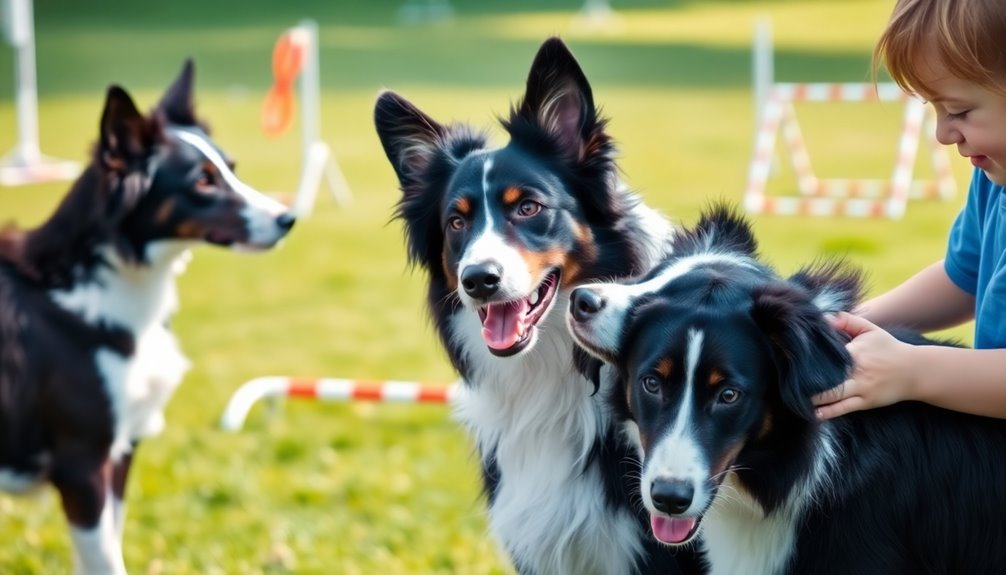
When it comes to training your Border Collie, you'll notice they're highly responsive to commands, making your job easier. Socializing them gradually in new environments is essential to build their confidence and prevent separation anxiety, especially in puppies. Providing consistent training and mental stimulation is crucial to redirecting their herding instincts positively.
Highly Responsive to Commands
Border Collies stand out as one of the most trainable dog breeds, thanks to their high intelligence and eagerness to learn. Their responsiveness to commands is remarkable, but it hinges on consistent training.
You'll find that training can take anywhere from a few weeks to a few months, depending on your dog's personality and the complexity of commands. Short, focused sessions work best to keep their attention, so aim for a structured schedule tailored to their learning pace.
Utilizing positive reinforcement techniques, like praise and treats, can significantly enhance your training experience. Clickers or whistles can help reinforce good behavior quickly. Rewarding desired actions redirects their herding instincts away from children or pets, building trust and strengthening your bond.
Early socialization is crucial. It helps your Border Collie navigate interactions with various people and animals, reducing their urge to over-herd. Start with basic commands in distracting environments, gradually increasing challenges.
Recall training should kick off around four months, and leash training should begin by ten weeks to manage those strong instincts effectively. Regular exercise is also vital, as it helps your dog burn off excess energy, allowing them to be a more calm and focused companion during training. Your efforts will pay off as your Border Collie becomes a highly responsive companion.
Gradual Exposure to New Environments
To help your Border Collie thrive, gradually exposing them to new environments is key. Start by familiarizing them with safe spaces, like your home and backyard, before venturing into new locations. This builds their confidence and helps manage hyperactivity and anxiety. Engaging in structured routines during these new experiences can further enhance their adaptability. Regular outings to dog parks can also provide valuable socialization opportunities.
Introduce small changes, such as new items or rearranged furniture, allowing your dog to adjust comfortably.
When exploring new environments, choose quieter areas, like less crowded sections of parks, to minimize stress. Engage your Collie in familiar activities and games to create a sense of security. Remember to reward calm behavior with treats, praise, or playtime, reinforcing positive associations with novel experiences.
Pay close attention to your dog's reactions. Look for signs of adaptability, such as relaxed body language and social engagement. If you notice excessive panting or hiding, slow down the process and retreat to quieter spots.
Building adaptability takes time, so be patient. Adjust the pace of exposure based on your dog's comfort level to ensure a smooth transition. With consistent, positive reinforcement, your Border Collie will learn to view new experiences as opportunities rather than threats.
Separation Anxiety in Puppies
Separation anxiety can be a challenging issue for puppies, especially in breeds like the Border Collie that thrive on close human connection. These dogs are bred to bond closely with their owners, so when you leave them alone, they might react with distress. If your puppy lacks mental and physical stimulation, their anxiety can worsen, leading to excessive barking, destructive behaviors, or even accidents in the house.
To address separation anxiety, start with positive reinforcement training to build trust. Gradually increase the time your puppy spends alone, helping them adjust to being independent. Early intervention is crucial to prevent worsening symptoms and ensure your puppy learns to cope effectively.
Incorporate mental stimulation through puzzle toys and engage in physical activities to burn off excess energy. Consistent daily routines can also help reduce anxiety. Socialization is crucial, too—early exposure to different environments will make your puppy feel more secure.
Create a safe space where they can relax when you're away, and consider using calming aids like pheromone diffusers.
Ideal Living Environment
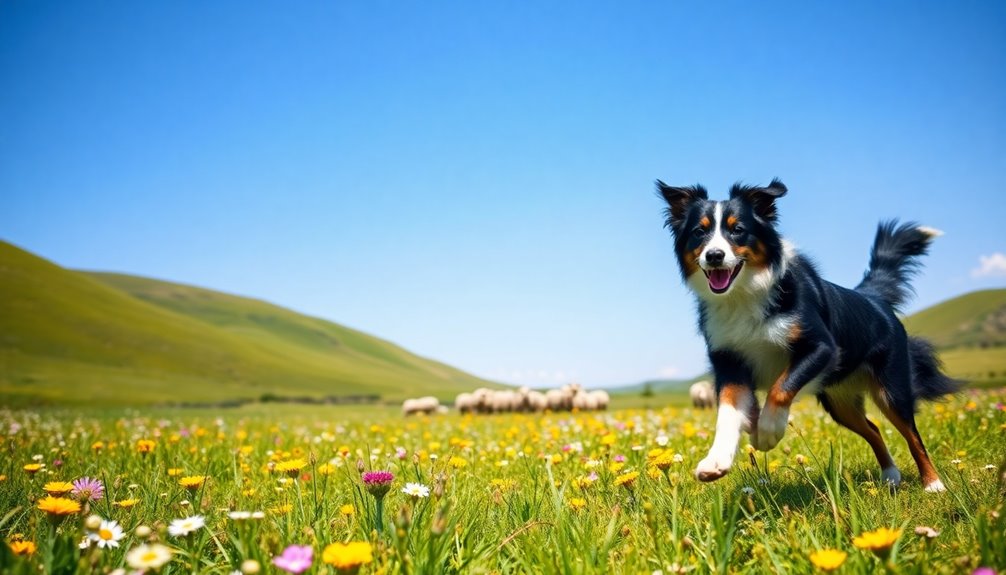
If you're considering bringing a Border Collie into your home, you'll want ample space for them to roam and play.
They thrive in moderate to cold temperatures, so a house with a yard or access to open areas is ideal.
Creating a comfortable environment will help your Border Collie feel secure and happy. Additionally, providing a secure yard is essential to prevent them from escaping due to their strong herding instincts.
House With Ample Space
Having plenty of space is crucial for Border Collies to thrive, as these energetic dogs were bred for herding in vast open areas.
If you have a home with a yard or access to open land, you're providing an ideal environment for your Border Collie. These dogs can feel confined and stressed in urban settings, where noise and constant activity surround them.
They're sensitive creatures that need a peaceful atmosphere to relax and recharge. A quiet, rural, or suburban area is much more suitable, allowing your Border Collie to explore and play without the overwhelming distractions of city life. With their strong genetic predisposition for problem-solving, your Border Collie will benefit from an environment that encourages mental challenges alongside physical activities.
With ample space, they can engage in physical activities essential for their mental and emotional well-being. You'll find that they enjoy having room to run and express their natural instincts.
Temperature Tolerance: Moderate to Cold
Border Collies thrive in environments that can accommodate their needs, including temperature preferences that lean towards moderate to cold conditions. Originating as working dogs in chilly climates, they've a dense double coat that insulates them well against the cold.
Ideally, they're most comfortable in temperatures ranging from 30°F to 70°F (-1°C to 21°C). However, be cautious, as they struggle in extremely low temperatures, especially below freezing.
Watch for signs of cold stress, like shivering, reluctance to go outside, or curling up tightly. If you notice these behaviors, provide warmth and comfort by ensuring a cozy sleeping area and a suitable dog coat for outdoor activities.
Regular grooming helps maintain their coat's insulating properties, which is essential for cold sensitivity. While regular exercise is vital, adjust the duration and intensity during severe cold spells. Indoor games can supplement outdoor activities on particularly frigid days.
Also, keep an eye on their diet, ensuring it supports their energy needs in colder temperatures. By being attentive to their comfort and activity levels, you can help your Border Collie thrive in a moderate to cold environment.
Famous for Agility Competitions
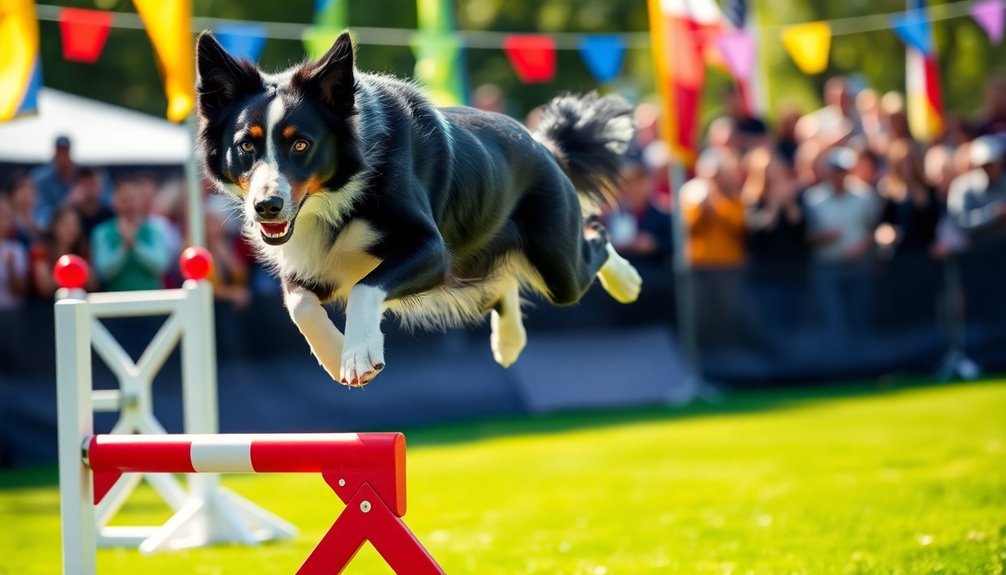
When you watch agility competitions, it's hard to miss how Border Collies stand out as the champions.
Their impressive speed and sharp obedience make them the top contenders, showcasing skills that stem from their herding roots. Additionally, Border Collies have historically dominated competitions, winning numerous titles such as the 2019 Masters Agility Champion. Plus, their popularity soared even more after starring in the beloved movie "Babe," which highlighted their intelligence and versatility.
World's Best Sheep Herders
In the world of herding, few breeds match the Border Collie's remarkable skills and agility. Originally bred to herd sheep, these dogs leverage their strength, stamina, and intelligence to excel in herding tasks. They employ a unique technique known as "the eye," where they use an intense stare to intimidate sheep into moving, a skill rooted in their wolf ancestry.
To develop their herding abilities, you'll need to introduce them to sheep at a young age. Training involves teaching them to circle, gather, and pen livestock, starting from simple tasks and progressing to more complex ones. They'll learn to respond to voice, whistle, and hand signals, ensuring a smooth herding process that minimizes stress for both the sheep and themselves. This training is essential for maintaining control during herding, as it helps to create well-managed flocks with minimal confusion.
Border Collies aren't just exceptional herders; their agility shines in competitions too. Their athleticism and quick response to commands make them champions, having dominated agility trials since the late 1970s.
Recognized for their herding prowess, these dogs are invaluable on farms, showcasing teamwork and skill that set them apart as the world's best sheep herders.
Famous in 'Babe' Movie
Agility competitions showcase the incredible talents of Border Collies, making them stars both in the ring and on the big screen. Known for their dominance in events like the Westminster Kennel Club's agility competition, these dogs have consistently left their mark since the competition began in 2014. With six top wins under their collar, they've proven time and again that they can outperform other breeds.
Take Verb, for instance, who won the Masters Agility Champion title in 2019 with a remarkable time of 32 seconds. Then there's P!nk, who dazzled the audience in 2020 by clinching the overall Masters title with an astounding 29.35 seconds. In fact, 44 Border Collies participated in the 2020 agility competition, showcasing the breed's popularity and strength in the sport.
Their success stems from their incredible speed, intelligence, and ability to follow commands, allowing them to navigate complex courses filled with jumps, tunnels, and weave poles. Training a Border Collie for agility involves positive reinforcement techniques, setting them up for success from the start.
It's this combination of agility, teamwork, and unmatched trainability that places Border Collies at the pinnacle of agility competitions, showcasing their skills and making them beloved stars.
Active Lifestyle Compatibility?
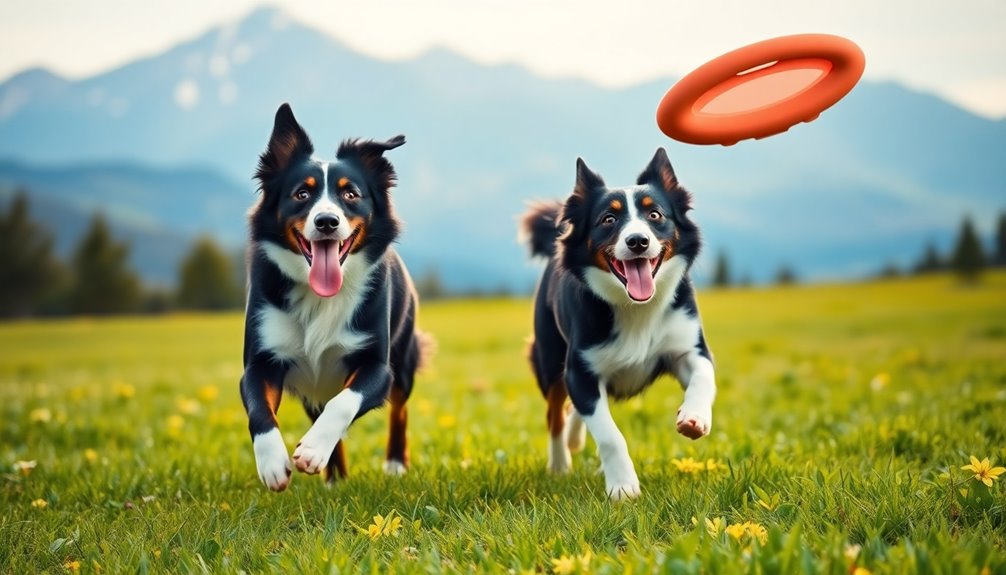
If you lead an active lifestyle, a Border Collie could be the perfect companion for you.
These dogs thrive on high energy activities and require daily exercise to stay happy and healthy. Their genetic drive to run and herd necessitates ample space for play and exploration. Be ready to commit to their needs, as they depend on you for regular engagement and stimulation.
High Energy, Active Lifestyle Needed
Border Collies thrive on activity and require an owner who matches their high energy. If you lead an active lifestyle, you'll find that these dogs are perfect companions. They need at least one hour of vigorous exercise each day—think long walks, runs, and hikes. Engaging in dog sports like agility or obedience training can also channel their boundless energy positively.
These intelligent dogs aren't just about physical exercise; they need mental stimulation too. Incorporating puzzle toys, training sessions, and interactive games into their routine helps keep their minds sharp and engaged. This dual focus on physical and mental activity prevents boredom and curbs unwanted behaviors, like excessive barking or chewing. Additionally, regular physical activity is essential for their overall happiness and health.
If you're a runner or an athlete, you'll be well-suited to handle a Border Collie's needs. They thrive in environments where they can constantly participate in various activities, so having ample space for exercise, like a backyard, is ideal.
However, they're not typically recommended for first-time dog owners unless you're fully committed to investing in their training and exercise requirements.
Commitment to Daily Exercise
A commitment to daily exercise is essential for anyone considering a Border Collie as a pet.
These dogs require a minimum of two hours of exercise each day to stay healthy and happy. You can break this up into several walks and off-lead activities, but it's crucial to include a mix of physical and mental stimulation. Long walks, like an hour in the morning and another in the evening, are a must. Additionally, regular exercise is crucial for their physical and mental health.
Physical activities such as running, chasing balls, and playing fetch are great for burning off energy.
To keep your Border Collie mentally engaged, consider puzzle feeders and training sessions. Activities like agility training and dog sports can also be highly beneficial.
Frequently Asked Questions
How Do Border Collies Communicate With Their Owners?
Border Collies communicate with you through a mix of body language, vocalizations, and interactive cues.
You'll notice their tail positions and ear postures conveying emotions. Their barks can express needs or warnings, while whining might indicate something's bothering them.
They also use touch and anticipate your commands, showcasing their intelligence. Engaging them with mental exercises keeps them happy and strengthens your bond, making communication even more effective.
What Are Common Behavioral Issues in Border Collies?
Common behavioral issues in Border Collies often stem from their high energy and strong instincts.
If you don't provide enough physical and mental stimulation, your dog might become bored, leading to destructive behaviors. They can also exhibit herding instincts, which may result in chasing or nipping.
Additionally, separation anxiety is a concern, causing vocalization or attempts to escape when left alone.
Training and socialization are crucial to managing these behaviors effectively.
Can Border Collies Adapt to Apartment Living?
Yes, you can help Border Collies adapt to apartment living, but it requires dedication.
You'll need to ensure they receive at least 1-2 hours of exercise daily, incorporating both physical activities and mental stimulation. Engage them with puzzle toys and regular training sessions to keep them happy.
Make sure your apartment has enough space for movement, and manage their exposure to external stimuli to prevent boredom and behavioral issues.
What Toys Are Best for Border Collies?
When choosing toys for your Border Collie, consider interactive and puzzle toys like the MultiPuzzle or Nina Ottosson toys to stimulate their intelligence.
Treat-dispensing toys, such as the Kong Wobbler, keep them engaged and rewarded.
For playtime, opt for tug and fetch toys like the Chuckit Ultra Ball.
Don't forget enrichment options like snuffle mats, which cater to their natural foraging instincts.
These choices will keep your pup entertained and mentally stimulated!
How Do Border Collies Perform in Obedience Training?
Border Collies excel in obedience training due to their intelligence and eagerness to please.
You'll find they respond best to positive reinforcement methods like treats, affection, or playtime. Consistency and patience are key; keep training sessions short to maintain their focus.
Incorporate a mix of commands and activities to keep things interesting. Their natural agility and energy make them quick learners, so they'll thrive in structured environments with regular practice.
Conclusion
In conclusion, Border Collies truly stand out as one of the smartest dog breeds, thanks to their keen intelligence and boundless energy. They thrive in active environments and require consistent training and socialization to reach their full potential. If you're ready to commit to their needs, you'll find a loyal and enthusiastic companion that brings joy and excitement to your life. Embrace the challenge, and you'll discover the incredible bond you can share with these remarkable dogs.

